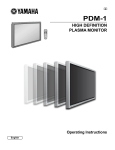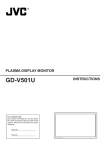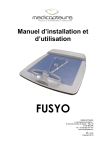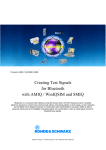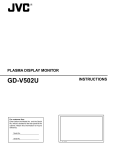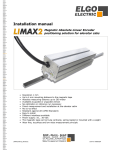Download Yamaha PDM-1 50 in. Plasma Television
Transcript
R PDM-1 INPUT INPUT SURROUND VOL VOL N R PICTURE PICTURE PICTURE POS. /SIZE SOUND SOUND HIGH DEFINITION PLASMA MONITOR SET SET UP UP ASPECT ASPECT OFF TIMER PC PC + – VOL INPUT POWE R / Y R - STANDB ON G POWER Operating Instructions English TQZW251 2 Table of Contents Important Safety Notice .............................................. 4 Safety Precautions ...................................................... 5 Accessories ................................................................. 7 Accessories Supply .................................................... 7 Optional Accessories ................................................. 7 Remote Control Batteries ........................................... 8 Connections ................................................................ 9 Basic connection ...................................................... 10 Speaker Terminals connection ................................. 11 Component/RGB Input connection .......................... 12 PC Input Terminals connection ................................ 13 SERIAL Terminals connection .................................. 15 Basic Controls ........................................................... 16 Power On/Off and input signal selection ................ 18 AC cord connection .................................................. 18 Power On/Off ........................................................... 18 Select the input signal .............................................. 19 Selecting the On-Screen Menu Language ............... 19 On-Screen Menu Display from Remote Control ..... 20 ASPECT Controls ...................................................... 22 Adjusting Picture Pos./Size ..................................... 24 Sound Adjustment .................................................... 26 Mute ......................................................................... 26 Surround Controls .................................................... 27 Picture Adjustments ................................................. 28 Advanced settings .................................................... 29 Set up TIMER ............................................................. 30 PRESENT TIME Set ................................................ 30 TIMER Set ............................................................... 31 Screensaver (For preventing after-images) ............ 32 Setup of Screensaver Time ...................................... 33 Side Panel Adjustment ............................................. 33 Setup for Input Signals ............................................. 34 Component/RGB-in select ....................................... 34 3D Y/C Filter – For NTSC AV images ...................... 34 Colour system / Aspect Auto .................................... 35 3:2 Pulldown ............................................................ 35 Sync ......................................................................... 36 H-Freq. (kHz)/V-Freq. (Hz) ....................................... 36 Troubleshooting ........................................................ 37 Specifications ............................................................ 38 3 Important Safety Notice WARNING: To prevent damage which may result in fire or shock hazard, do not expose this appliance to rain or moisture. Do not place containers with water (flower vase, cups, cosmetics, etc.) above the set. (including on shelves above, etc.) WARNING: 1) To prevent electric shock, do not remove cover. No user serviceable parts inside. Refer servicing to qualified service personnel. 2) Do not remove the earthing pin on the power plug. This apparatus is equipped with a three pin earthing-type power plug. This plug will only fit an earthing-type power outlet. This is a safety feature. If you are unable to insert the plug into the outlet, contact an electrician. Do not defeat the purpose of the earthing plug. WARNING This is a class A product. In a domestic environment this product may cause radio interference in which case you may be required to take adequate measures. CAUTION This appliance is intended for use in environments which are relatively free of electromagnetic fields. Using this appliance near sources of strong electromagnetic fields or where electrical noise may overlap with the input signals could cause the picture and sound to wobble or cause interference such as noise to appear. To avoid the possibility of harm to this appliance, keep it away from sources of strong electromagnetic fields. To prevent electric shock, ensure the grounding pin on the AC cord power plug is securely connected. Trademark Credits VGA is a trademark of International Business Machines Corporation. Macintosh is a registered trademark of Apple Computer, USA. S-VGA is a registered trademark of the Video Electronics Standard Association. Even if no special notation has been made of company or product trademarks, these trademarks have been fully respected. • • • Note: Do not allow a still picture to be displayed for an extended period, as this can cause a permanent after-image to remain on the plasma display. Examples of still pictures include logos, video games, computer images, teletext and images displayed in 4:3 mode. 4 Safety Precautions WARNING Setup This plasma display is for use only with the following optional accessories. Use with any other type of optional accessories may cause instability which could result in the possibility of injury. PDS-150 • Pedestal .......................................... .......................... Wall Mounting Unit PWK-150 • ......................................... Speakers SP-PDM1 • (In the case of connecting the speakers directly with the speaker terminals of the plasma display) Always be sure to ask a qualified technician to carry out set-up. Do not place the plasma display on sloped or unstable surfaces. The plasma display may fall off or tip over. • Do not place any objects on top of the plasma display. If water is spills onto the plasma display or foreign objects get inside it, a short-circuit may occur which could result in fire or electric shock. If any foreign objects get inside the plasma display, please consult your local Yamaha dealer. • If using the pedestal (optional accessory), leave a space of at least 10 cm at the top, left and right, at least 6 cm at the bottom, and at least 7 cm at the rear. If using some other setting-up method, leave a space of at least 10 cm at the top, bottom, left and right, and at least 1.9 cm at the rear. Avoid installing this product near electronic equipment that is easy to receive electromagnetic waves. It may cause interference in image, sound, etc. In particular, keep video equipment away from this product. • When using the plasma display The plasma display is designed to operate on 220 - 240 V AC, 50/60 Hz. Do not cover the ventilation holes. Doing so may cause the plasma display overheat, which can cause fire or damage to the plasma display. • Do not stick any foreign objects into the plasma display. Do not insert any metal or flammable objects into the ventilations holes or drop them onto the plasma display, as doing so can cause fire or electric shock. • Do not remove the cover or modify it in any way. High voltages which can cause severe electric shocks are present inside the plasma display. For any inspection, adjustment and repair work, please contact your local Yamaha dealer. • Securely insert the power cord plug as far as it will go. If the plug is not fully inserted, heat may be generated which could cause fire. If the plug is damaged or the wall socket plate is loose, they shall not be used. • Do not handle the power cord plug with wet hands. Doing so may cause electric shocks. • Do not do anything that may damage the power cable. When disconnecting the power cable, pull on the plug body, not the cable. Do not damage the cable, make any modifications to it, place heavy objects on top of it, heat it, place it near any hot objects, twist it, bend it excessively or pull it. To do so may cause fire and electric shock. If the power cable is damaged, have it repaired at your local Yamaha dealer. • If the plasma display is not going to be used for any prolonged length of time, unplug the power cord plug from the wall outlet. 5 Safety Precautions If problems occur during use If a problem occurs (such as no picture or no sound), or if smoke or an abnormal odour starts to come out from the plasma display, immediately unplug the power cord plug from the wall outlet. If you continue to use the plasma display in this condition, fire or electric shock could result. After checking that the smoke has stopped, contact your local Yamaha dealer so that the necessary repairs can be made. Repairing the plasma display yourself is extremely dangerous, and shall never be done. • If water or foreign objects get inside the plasma display, if the plasma display is dropped, or if the cabinet becomes damages, disconnect the power cord plug immediately. A short circuit may occur, which could cause fire. Contact your local Yamaha dealer for any repairs that need to be made. • CAUTION When using the plasma display Do not bring your hands, face or objects close to the ventilation holes of the plasma display. Heated air comes out from the ventilation holes at the top of plasma display will be hot. Do not bring your hands or face, or objects which cannot withstand heat, close to this port, otherwise burns or deformation could result. • Be sure to disconnect all cables before moving the plasma display. If the plasma display is moved while some of the cables are still connected, the cables may become damaged, and fire or electric shock could result. • Disconnect the power cord plug from the wall socket as a safety precaution before carrying out any cleaning. Electric shocks can result if this is not done. • Clean the power cable regularly to prevent it becoming dusty. If dust built up on the power cord plug, the resultant humidity can damage the insulation, which could result in fire. Pull the power cord plug out from the wall outlet and wipe the mains lead with a dry cloth. • This Plasma Display radiates infrared rays, therefore it may affect other infrared communication equipment. Install your infrared sensor in a place away from direct or reflected light from your Plasma Display. Cleaning and maintenance The front of the display panel has been specially treated. Wipe the panel surface gently using only a cleaning cloth or a soft, lint-free cloth. If the surface is particularly dirty, wipe with a soft, lint-free cloth which has been soaked in pure water or water to which a small amount of neutral detergent has been added, and then wipe it evenly with a dry cloth of the same type until the surface is dry. Do not scratch or hit the surface of the panel with fingernails or other hard objects, otherwise the surface may become damaged. Furthermore, avoid contact with volatile substances such as insect sprays, solvents and thinner, otherwise the quality of the surface may be adversely affected. • • If the cabinet becomes dirty, wipe it with a soft, dry cloth. If the cabinet is particularly dirty, soak the cloth in water to which a small amount of neutral detergent has been added and then wring the cloth dry. Use this cloth to wipe the cabinet, and then wipe it dry with a dry cloth. Do not allow any detergent to come into direct contact with the surface of the plasma display. If water droplets get inside the unit, operating problems may result. Avoid contact with volatile substances such as insect sprays, solvents and thinner, otherwise the quality of the cabinet surface may be adversely affected or the coating may peel off. Furthermore, do not leave it for long periods in contact with articles made from rubber or PVC. • • • 6 Accessories Accessories Supply Check that you have the accessories and items shown Remote Control Transmitter Batteries for the Remote Control Transmitter (2 × R6 Size) Fixing bands 2 pcs AC cord (Australia) Ferrite core (small size) × 1 INPUT SURROUND VOL N R PICTURE SOUND PICTURE POS. /SIZE SET UP ASPECT OFF TIMER PC AC cord Ferrite core (large size) × 2 Optional Accessories • Speakers SP-PDM1 (Special order products) • Pedestal PDS-150 • Wall Mounting Unit PWK-150 For assembling Full instructions are supplied with each optional accessory for use with this plasma display. 7 Remote Control Batteries Requires two R6 batteries. 1. Turn the transmitter face down. Press and slide off the battery cover. 2. Install the batteries as shown in the battery compartment. (Polarity + or – must match the markings in the compartment.) 3. Replace the cover and slide in reverse until the lock snaps. Two "R6" size Helpful Hint: For frequent remote control users, replace old batteries with Alkaline batteries for longer life. Precaution on battery use Incorrect installation can cause battery leakage and corrosion that will damage the remote control transmitter. Observe the following precaution: 1. Batteries shall always be replaced as a pair. Always use new batteries when replacing the old set. 2. Do not combine a used battery with a new one. 3. Do not mix battery types (example: “Zinc Carbon” with “Alkaline”). 4. Do not attempt to charge, short-circuit, disassemble, heat or burn used batteries. 5. Battery replacement is necessary when remote control acts sporadically or stops operating the plasma display set. 8 Connections AC cord connection (see page 18) – Cable fixing bands Secure any excess cables with bands, as required. To secure cables connected to Terminals, wrap the cable fixing band around them then pass the pointed end through the locking block, as shown in the figure. While ensuring there is sufficient slack in cables to minimize stress (especially in the power cord), firmly bind all cables with the supplied fixing band. Pass the attached cable fixing band through the clip as shown in the figure. 1 2 To tighten: To loosen: Push the catch Pull Pull AUDIO R L R AUDIO VIDEO AV IN AV IN Terminals (see page 10, 11) S VIDEO L AUDIO VD HD PR/CR/R PB/CB/B COMPONENT/RGB IN COMPONENT/RGB IN and Audio IN Terminals (see page 10, 11, 12) Y/G PC IN From EXIT monitor Terminal on Computer (see page 13) SERIAL From SERIAL Terminal on Computer (see page 15) 9 Connections Basic connection (Example) When connecting an AV amplifier S VIDEO 4 pin socket AUDIO VIDEO S VIDEO Chrominance earth Luminance in Chrominance in L R L R Luminance earth AUDIO HD VD AV IN PR/CR/R PB/CB/B Y/G COMPONENT/RGB IN Video pin cable S Video cable Component Video cable AV amplifier VOLUME INPUT SELECTOR VIDEO S VIDEO INPUT MODE STANDBY /ON SPEAKERS A B 6CH INPUT PROGRAM STEREO FM/AM PRESET /TUNING A/B/C/D/E PRESET /TUNING EDIT EFFECT BASS BALANCE TREBLE MEMORY SAT MD/TAPE CD–R TUNER VCR 1 1 ON VCR 2 OFF COMPONENT VIDEO TUNING MODE MAN'L/AUTO FM AUTO/MAN'L MONO SOURCE/REMOTE D–TV/LD DVD CABLE PROCESSOR BASS DIRECT EXTENSION CD PHONO L SILENT R VIDEO AUX VCR 3/DVR MONITOR OUT VIDEO AUX PHONES S VIDEO VIDEO L REC OUT/ZONE 2 AUDIO R MONITOR OUT OPTICAL 2 Subwoofer Center speaker Front effect speaker Rear speaker Main speaker Main speaker Rear speaker Front effect speaker Notes: (1) Change the “Component/RGB-in” setting in the “Setup” menu to “Component”. (see page 34) (2) Any equipment and cables other than the display illustrated above are not included. (3) Choose one connecting cable from Video, S Video or Component Video, that is suitable for the equipment being used. (4) Generally the quality of images obtained varies between connection methods in the descending order of Component Video, S Video and Video. 10 Connections Speaker Terminals connection When you do not use an AV amplifier, connect the speakers directly with the speaker terminals of the plasma display. Refer to the speaker’s Installation Manual for details on speaker installation. When connecting the speakers, be sure to use only the optional accessory speakers. Speakers (Optional accessories) 1 3 2 1 Remove the tubes from the ends of the speaker cables. 2 SPEAKERS Terminals (L) SPEAKERS Terminals (R) R R L VIDEO AUDIO S VIDEO L AUDIO VD AV IN 21pin scart cable Audio pin cable R (DVD Player) VIDEO signal connection with 21pin scart cable PR/CR/R PB/CB/B Y/G Audio pin cable Video pin cable TV OUT HD COMPONENT/RGB IN Component Video cable S Video cable Audio OUT L Video OUT S Video OUT (DVD Player) VIDEO or S VIDEO signal connection R Audio OUT L Component Video OUT Y PB PR (DVD Player) Component signals (Y, PB, PR) connection Notes: (1) Change the “Component/RGB-in” setting in the “Setup” menu to “Component”. (see page 34) (2) Any equipment and cables other than the display illustrated above are not included. (3) Choose one connecting cable from Video, S Video or Component Video, that is suitable for the equipment being used. (4) Generally the quality of images obtained varies between connection methods in the descending order of Component Video, S Video and Video. (5) When utilizing the R/G/B/Video signals from the TV OUT(SCART) terminal of a DVD player or similar, use a 4-pin cable to connect signals to the appropriate input terminal of the display. 11 Connections Component/RGB Input connection RGB signal (R, G, B, HD, VD) connection BNC-RCA adaptor plug RGB input to R, G, B, HD, VD sockets Example of input signal source HDTV-compatible VCR 5×BNC RGB cables RGB camera R L AUDIO VD HD PR/CR/R PB/CB/B Y/G COMPONENT/RGB IN AUDIO 2×RCA audio cables Audio input to L/R sockets Computer VD HD R B G Notes: (1) Change the “Component/RGB-in” setting in the “Setup” menu to “RGB”. (see page 34) (2) Any equipment and cables other than the display illustrated above are not included. (3) Choose one connecting cable from Video, S Video or Component Video, that is suitable for the equipment being used. (4) Generally the quality of images obtained varies between connection methods in the descending order of Component Video, S Video and Video. 12 Connections PC Input Terminals connection COMPUTER AUDIO PC IN POWER / R - STANDBY INPUT — VOL + G POWER ON Conversion adapter (if necessary) Less than 3" 15/16 (10 cm) Ferrite core (large size) (supplied) D-sub 15p RGB PC cable Ferrite core (small size) (supplied) Less than 3" 15/16 (10 cm) Audio 1/8" (3 mm)Stereo plug Connect a cable which matches the audio output terminal on the computer. Installing the ferrite core (Small size) 1 2 3 Open Press the cable through and close Pull back the tabs (in two places) Installing the ferrite core (Large size) 1 2 3 Open Pull back the tabs (in two places) Press the cable through and close Notes: (1) Computer signals which can be input are those with a horizontal scanning frequency of 15.6 to 110 kHz and vertical scanning frequency of 48 to 120 Hz. (However, the image will not be displayed properly if the signals exceed 1,200 lines.) (2) The display resolution is a maximum 1,024 × 768 dots when the aspect mode is set to “4:3”, and 1,366 × 768 dots when the aspect mode is set to “16:9”. If the display resolution exceeds these maximums, it may not be possible to show fine detail with sufficient clarity. (3) The PC input terminals are DDC1/2B-compatible. If the computer being connected is not DDC1/2B-compatible, you will need to make setting changes to the computer at the time of connection. (4) Some PC models cannot be connected to the set. (5) There is no need to use an adapter for computers with DOS/V compatible D-sub 15P terminal. (6) The computer shown in the illustration is for example purposes only. (7) Additional equipment and cables shown are not supplied with this set. (8) Do not set the horizontal and vertical scanning frequencies for PC signals which are above or below the specified frequency range. 13 Connections Signal Names for D-sub 15P Connector Pin No. 1 2 3 4 5 11 12 13 14 15 6 7 1 9 10 8 2 3 4 5 Pin Layout for PC Input Terminal Signal Name R G B GND (Ground) GND (Ground) Pin No. Signal Name Pin No. 6 GND (Ground) 11 7 GND (Ground) 12 8 GND (Ground) 13 9 NC (not connected) 14 10 GND (Ground) 15 Signal Name GND (Ground) SDA HD/SYNC VD SCL AV/Component/RGB/PC input signals AUDIO R R L VIDEO AUDIO S VIDEO AV IN AV input L AUDIO VD HD PR/CR/R PB/CB/B Y/G COMPONENT/RGB IN PC Component/RGB input IN SERIAL PC RGB input AV input signal name 1 2 3 4 5 NTSC PAL PAL60 SECAM Modified NTSC horizontal frequency(kHz) 15.734 15.625 15.734 15.625 15.734 vertical frequency(Hz) 59.95 50 59.95 50 59.95 Input signal can be displayed. Component/RGB/PC input signal name 1 2 3 4 5 6 7 8 9 10 11 12 13 14 15 16 17 18 19 20 21 22 23 24 25 26 27 14 525 (480) /60i 625 (575) /50i 525 (480) /60p 625 (575) /50p 750 (720) /60p 1,125 (1,080) /60i 1,125 (1,080) /50i 1,125 (1,080) /24p 1,125 (1,080) /24sF 640 × 400 @70 640 × 480 @60 Macintosh13” (640 × 480) 640 × 480 @75 852 × 480 @60 800 × 600 @60 800 × 600 @75 800 × 600 @85 Macintosh16” (832 × 624) 1,024 × 768 @60 1,024 × 768 @70 1,024 × 768 @75 1,024 × 768 @85 Macintosh21” (1,152 × 870) 1,280 × 1,024 @60 1,280 × 1,024 @75 1,280 × 1,024 @85 1,600 × 1,200 @60 ∗ Mark: horizontal frequency(kHz) 15.734 15.625 31.468 31.25 45 33.75 28.125 27 27 31.5 31.5 35 37.5 31.7 37.9 46.9 53.7 49.7 48.4 56.5 60 68.7 68.7 64 80 91.1 75 vertical frequency(Hz) 59.94 50 59.94 50 60 60 50 24 48 70 59.94 67 75 60 60 75 85 75 60 70 75 85 75 60 75 85 60 Component RGB PC ∗ ∗ ∗ ∗ ∗ ∗ ∗ ∗ ∗ ∗ ∗ ∗ ∗ ∗ ∗ ∗ ∗ ∗ ∗ ∗ ∗ ∗ ∗ ∗ ∗ ∗ ∗ ∗ ∗ ∗ ∗ ∗ ∗ ∗ ∗ ∗ ∗ ∗ ∗ ∗ ∗ ∗ ∗ ∗ ∗ ∗ ∗ ∗ ∗ ∗ ∗ ∗ ∗ ∗ ∗ ∗ ∗ ∗ ∗ ∗ ∗ ∗ Connections SERIAL Terminals connection The SERIAL terminal is used when the plasma display is controlled by a computer. 6 1 7 2 8 3 9 4 5 Pin layout for RS-232C Notes: (1) Use the RS-232C cable to connect the computer to the plasma display. (2) The computer shown is for example purposes only. (3) Additional equipment and cables shown are not supplied with this set. The SERIAL terminal conforms to the RS-232C interface specification, so that the plasma display can be controlled by a computer which is connected to this terminal. The computer will require software which allows the sending and receiving of control data which satisfies the conditions given below. Use a computer application such as programming language software. Refer to the documentation for the computer application for details. Communication parameters Signal level Synchronization method Baud rate Parity Character length Stop bit Flow control RS-232C compliant Asynchronous 9600 bps None 8 bits 1 bit - Basic format for control data The transmission of control data from the computer starts with a STX signal, followed by the command, the parameters, and lastly an ETX signal in that order. If there are no parameters, then the parameter signal does not need to be sent. STX C1 C2 C3 Start (02h) : P1 P2 P3 P4 P5 ETX Colon Parameter(s) (1 - 5 bytes) 3-character command (3bytes) End (03h) Notes: (1) If multiple commands are transmitted, be sure to wait for the response for the first command to come from this unit before sending the next command. (2) If an incorrect command is sent by mistake, this unit will send an “ER401” command back to the computer. RS-232C Conversion cable D-sub 9-pin female Details 2 RXD 3 TXD GND 5 Non use 4 • 6 7 Shorted 8 NC 1 • 9 Command Command PON POF AVL AMT IIS DAM Parameter None None ** 0 1 None VID YP1 RG1 None NORM ZOOM FULL JUST SELF Control details Power ON Power OFF Volume 00 - 63 Audio mute OFF Audio mute ON Input select (toggle) AV Mode Component / RGB mode (processed as a Y/PB/PR or RGB signals as set by this unit) PC Mode Screen mode select (toggle) 4:3 Zoom 16 : 9 Just Auto With the power off, this display responds to PON command only. 15 Basic Controls INPUT R - STANDBY G POWER ON — VOL + PDM-1 Main Power On/Off Switch Power Indicator The Power Indicator will light. Power-OFF ..... Indicator not illuminated (The unit will still consume some power as long as the power cord is still inserted into the wall outlet.) Stand-by .... Red Power-ON ...... Green • • • INPUT button (AV(S Video), Component/RGB and PC Mode Selection) Press the “INPUT” button to select AV (S Video), Component/RGB and PC input signal modes sequentially. (see page 19) Volume Adjustment Press the Volume Up “+” or Down “–” button to increase or decrease the sound volume level. Stand-by (ON/OFF) button The plasma display must first be plugged into the wall outlet and turned on at the power switch (see page 18). Press this button to turn the plasma display On, from Stanby mode. Press it again to turn the plasma display Off to Stanby mode. Status button Press the “Status” button to display the current system status. 4:3 Off timer N button (see page 25, 26, 28, 29) 1 AV 2 90 3 1 AV(S Video), Component/RGB, PC mode 2 Aspect mode (see page 22) 3 Off timer The off timer indicator is displayed only when the off timer has been set. PICTURE button (see page 28) PICTURE POS./SIZE button (see page 24) PC button Press the “PC” mode selection button to select the PC mode. This button is used to switch directly to PC mode. 16 Basic Controls SURROUND button (see page 27) INPUT button (AV(S Video), Component/RGB and PC Mode Selection) Press to select AV(S Video), Component/RGB and PC input signal modes sequentially. (see page 19) Sound mute On/Off (see page 26) INPUT INPUT SURROUND Volume Adjustment Press the Volume Up “+” or Down “–” button to increase or decrease the sound volume level. VOL VOL R button (see page 21) N R ACTION button Press to make selections POSITION buttons PICTURE PICTURE SOUND SOUND SET SET UP UP SET UP button (see page 20) SOUND button (see page 26) PICTURE POS. /SIZE ASPECT ASPECT OFF TIMER PC ASPECT button Press to adjust the aspect. (see page 22) PC OFF TIMER button The plasma display can be preset to switch to standby after a fixed period. The setting changes to 30 minutes, 60 minutes, 90 minutes and 0 minutes (off timer cancelled) each time the button is pressed. 30 60 90 0 When three minutes remain, “Off timer 3” will flash. The off timer is cancelled if a power interruption occurs. 17 Power On/Off and input signal selection AC cord connection Connecting the AC cord plug to the plasma display. Power On/Off Connecting the plug to the Wall Outlet Note: Main plug types vary between countries. The power plug shown at left may, therefore, not be the type fitted to your set. R - STANDBY INPUT – VOL switch on the plasma display to turn Press the the set on:Power-On. Power Indicator: Green + G POWER ON R - STANDBY G POWER ON PDM-1 Power Indicator Example: The screen below is displayed for a while after the plasma display is turned on. (setting condition is an example.) Remote Control Sensor When the Power is turned on for the first time, the Language selection screen is displayed. From the second time on, language selection can be done from the setup menu. (see page 19) Select the desired language using the and keys and press the ACTION button. INPUT OSD Language English (UK) Deutsch Fran ais Italiano Espa ol ENGLISH (US) Select From the second time on, the below screen is displayed for a while (setting condition is an example). AV 4:3 Set Press the button on the remote control to turn the plasma display off. Power Indicator: Red (standby) Press the button on the remote control to turn the plasma display on. Power Indicator: Green SURROUND VOL Turn the power to the plasma display set off by pressing N 18 R the switch on the plasma display, when the plasma display is on or in standby mode. Power On/Off and input signal selection Select the input signal INPUT Press the INPUT button to select the input AV signal desired from equipment such as a VCR which has been connected to the plasma display. Input signals will change as follows: R - STANDBY INPUT — VOL + For Component Input (see page 34) G POWER ON AV INPUT — Component PC + VOL For RGB Input (see page 34) AV RGB PC INPUT SURROUND VOL N R Selecting the On-Screen Menu Language SET UP Press to display the Setup menu. Press to select the OSD Language. INPUT SURROUND Press to select your preferred language. VOL N Setup R Component/RGB-in select RGB Signal Screensaver Selectable languages English (UK) OSD Language PICTURE SOUND SET UP Set up TIMER English(UK) Deutsch Français Italiano Español ENGLISH(US) .......(Chinese) 19 On-Screen Menu Display from Remote Control To Picture adjust menu (see page 28) Press to select each item. Picture Normal Normalise Picture Mode Contrast Brightness Colour Tint Sharpness White balance Advanced settings Normal 20 0 0 0 0 INPUT Normal On SURROUND Setup To Advanced Settings (see page 28, 29) VOL RGB Advanced Settings Normal Normalise Black extension W/B High R W/B High B W/B Low R W/B Low B Gamma Component/RGB-in select N English (UK) OSD Language 0 0 0 0 0 Set up TIMER 2. 2 PICTURE To Sound adjust menu (see page 26) PICTURE POS. /SIZE SOUND SET UP ASPECT Setup Sound Normalise Sound Mode Bass Treble Balance Surround Signal Screensaver R OFF TIMER Normal Normal 0 0 0 Component/RGB-in select RGB PC Signal Screensaver On English (UK) OSD Language Set up TIMER NORMALIZE To Picture Pos./Size adjust menu (see page 24) During “AV(S Video)” and “Component” input signal modes. Picture Pos./Size Normalise H-Pos H-Size V-Pos V-Size Normal Setup During “RGB” and “PC” input signal modes. Picture Pos./Size Normal Normalise H-Pos H-Size V-Pos V-Size Clock Phase 20 Component/RGB-in select RGB Signal Screensaver English (UK) OSD Language Set up TIMER





















